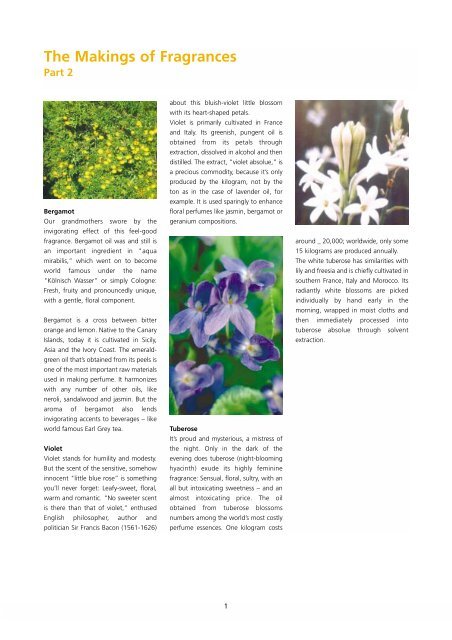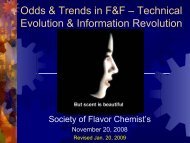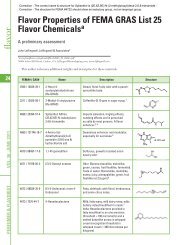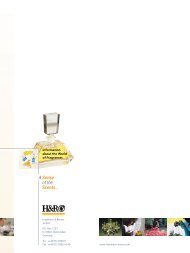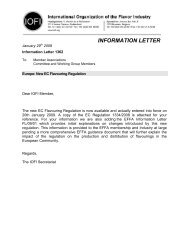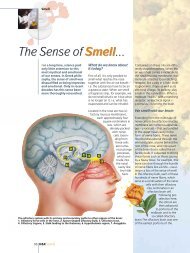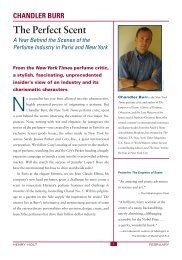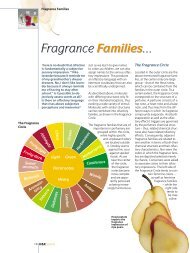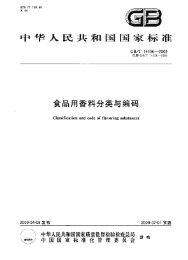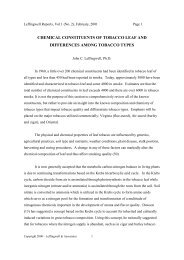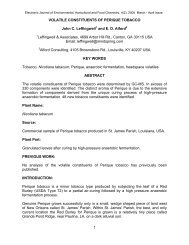The Makings of Fragrances
The Makings of Fragrances
The Makings of Fragrances
You also want an ePaper? Increase the reach of your titles
YUMPU automatically turns print PDFs into web optimized ePapers that Google loves.
<strong>The</strong> <strong>Makings</strong> <strong>of</strong> <strong>Fragrances</strong><br />
Part 2<br />
Bergamot<br />
Our grandmothers swore by the<br />
invigorating effect <strong>of</strong> this feel-good<br />
fragrance. Bergamot oil was and still is<br />
an important ingredient in "aqua<br />
mirabilis,” which went on to become<br />
world famous under the name<br />
"Kölnisch Wasser” or simply Cologne:<br />
Fresh, fruity and pronouncedly unique,<br />
with a gentle, floral component.<br />
Bergamot is a cross between bitter<br />
orange and lemon. Native to the Canary<br />
Islands, today it is cultivated in Sicily,<br />
Asia and the Ivory Coast. <strong>The</strong> emeraldgreen<br />
oil that’s obtained from its peels is<br />
one <strong>of</strong> the most important raw materials<br />
used in making perfume. It harmonizes<br />
with any number <strong>of</strong> other oils, like<br />
neroli, sandalwood and jasmin. But the<br />
aroma <strong>of</strong> bergamot also lends<br />
invigorating accents to beverages – like<br />
world famous Earl Grey tea.<br />
Violet<br />
Violet stands for humility and modesty.<br />
But the scent <strong>of</strong> the sensitive, somehow<br />
innocent "little blue rose” is something<br />
you’ll never forget: Leafy-sweet, floral,<br />
warm and romantic. "No sweeter scent<br />
is there than that <strong>of</strong> violet,” enthused<br />
English philosopher, author and<br />
politician Sir Francis Bacon (1561-1626)<br />
about this bluish-violet little blossom<br />
with its heart-shaped petals.<br />
Violet is primarily cultivated in France<br />
and Italy. Its greenish, pungent oil is<br />
obtained from its petals through<br />
extraction, dissolved in alcohol and then<br />
distilled. <strong>The</strong> extract, "violet absolue,” is<br />
a precious commodity, because it’s only<br />
produced by the kilogram, not by the<br />
ton as in the case <strong>of</strong> lavender oil, for<br />
example. It is used sparingly to enhance<br />
floral perfumes like jasmin, bergamot or<br />
geranium compositions.<br />
Tuberose<br />
It’s proud and mysterious, a mistress <strong>of</strong><br />
the night. Only in the dark <strong>of</strong> the<br />
evening does tuberose (night-blooming<br />
hyacinth) exude its highly feminine<br />
fragrance: Sensual, floral, sultry, with an<br />
all but intoxicating sweetness – and an<br />
almost intoxicating price. <strong>The</strong> oil<br />
obtained from tuberose blossoms<br />
numbers among the world’s most costly<br />
perfume essences. One kilogram costs<br />
around _ 20,000; worldwide, only some<br />
15 kilograms are produced annually.<br />
<strong>The</strong> white tuberose has similarities with<br />
lily and freesia and is chiefly cultivated in<br />
southern France, Italy and Morocco. Its<br />
radiantly white blossoms are picked<br />
individually by hand early in the<br />
morning, wrapped in moist cloths and<br />
then immediately processed into<br />
tuberose absolue through solvent<br />
extraction.<br />
1
White narcissus (Narcissus poeticus) is<br />
cultivated in France, Morocco and<br />
Egypt. <strong>The</strong> absolue is obtained from its<br />
petals. It has an earthy scent and only<br />
develops its wonderfully floral-sultry<br />
Mimosa<br />
It has a reputation for being extremely<br />
sensitive. And this preconception<br />
applies to "true” mimosa (Mimosa<br />
pudica): It closes its petals at the<br />
slightest touch, and doesn’t open them<br />
again until much later. However the<br />
mimosas that are used to make<br />
perfumes have nothing to do with this<br />
variety, which is also termed the<br />
"sensitive plant.” Acacias, too, are also<br />
grown and traded under the name<br />
mimosa. But these "false” mimosas are<br />
indispensable for perfumers.<br />
Mimosa absolue is obtained from the<br />
blossoms and stem tips <strong>of</strong> the species<br />
Acacia decurrens. Native to Australia,<br />
today it is cultivated in Provence<br />
(southern France) and in Piedmont<br />
(northern Italy). <strong>The</strong> pleasant, gentle<br />
scent <strong>of</strong> mimosa harmonizes well with<br />
sandalwood and ylang-ylang.<br />
fragrance in diluted form. It is said to<br />
lend wings to the imagination and to<br />
s<strong>of</strong>ten the senses and make them<br />
receptive, even euphoric, with its<br />
appealing scent. It’s an effect that<br />
should not be underestimated: After all,<br />
this beautiful flower owes its name to<br />
Narcissus, a young man from Greek<br />
mythology who fell in love with his own<br />
reflection<br />
Narcissus<br />
<strong>The</strong> narcissus – also called daffodil –<br />
rings in the spring season and is<br />
considered to be a flower <strong>of</strong> promise: In<br />
days gone bye, if a young man gave<br />
white narcissi to the love <strong>of</strong> his life, it<br />
was taken to be a token <strong>of</strong> his deep<br />
affection.<br />
2


